SpringMVC + Spring 3.2.14 + Hibernate 3.6.10
SpringMVC + Spring 3.2.14 + Hibernate 3.6.10 集成详解
注:此文档只说明简单的框架集成,各个框架的高级特性未涉及,刚刚接触框架的新人可能需要参考其他资料。
PS:本次练习所用jar包都能在此下载到:http://pan.baidu.com/s/1sjmgdYX
- 准备工作
开发环境:JDK 7u80、Eclipse 4.4 、Tomcat 7.0.63、MySQL 5.6
开发使用组件:Spring 3.2.14、Hibernate 3.6.10、common-logging 1.2、aopalliance.jar、aspectjweaver.jar、mysql-connector-java-5.1.35-bin.jar
在Eclipse下创建动态web项目Test,创建过程中注意勾选web.xml的选项,如果不勾选,项目创建之后需要手动创建web.xml,创建完成后将其部署到Tomcat中,项目结构应该如下(Package Explorer下,看个人习惯):
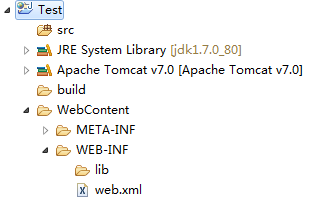
- 配置Spring
将以下JAR包复制到lib文件夹下,不要问为什么是这些,想知道为什么可以把其他任意一个删掉看看启动项目报什么错。

在web.xml中配置Spring监听器,代码如下:
<listener>
<listener-class>org.springframework.web.context.ContextLoaderListener</listener-class>
</listener>
创建applicationContext.xml,当前版本的Spring默认其位于WEB-INF下,不过大多数开发人员习惯还是将其放到src下,这里我们将其放在src下。之后向applicationContext.xml中添加bean相关声明,具体如下
<?xml version="1.0" encoding="UTF-8"?>
<beans xmlns="http://www.springframework.org/schema/beans"
xmlns:xsi="http://www.w3.org/2001/XMLSchema-instance"
xsi:schemaLocation="http://www.springframework.org/schema/beans
http://www.springframework.org/schema/beans/spring-beans-3.2.xsd">
</beans>
web.xml中添加如下内容,用于自定义Spring配置文件的位置:
<context-param>
<param-name>contextConfigLocation</param-name>
<param-value>classpath:applicationContext.xml</param-value>
</context-param>
新建测试实体类User,路径暂定为com.test.entity,添加如下代码:

package com.test.entity;
public class User {
private String id;
private String username;
private String password;
public String getId() {
return id;
}
public void setId(String id) {
this.id = id;
}
public String getUsername() {
return username;
}
public void setUsername(String username) {
this.username = username;
}
public String getPassword() {
return password;
}
public void setPassword(String password) {
this.password = password;
}
}

applicationContext.xml中添加如下定义(此处测试完成之后可以删除):
<bean id="user" class="com.test.entity.User">
<property name="username" value="test" />
</bean>
新建Test类,暂定路径com.test.test,添加如下代码:

package com.test.test;
import org.springframework.context.support.FileSystemXmlApplicationContext;
import com.test.entity.User;
public class Test{
@SuppressWarnings("resource")
public static void main(String[] args) {
FileSystemXmlApplicationContext ac =
new FileSystemXmlApplicationContext("src\\applicationContext.xml");
User user = (User) ac.getBean("user");
System.out.println(user.getUsername());
}
}

运行Test类查看结果,如果输出test则表示spring框架运行正常。
- 配置SpringMVC
添加SpringMVC所需JAR包:spring-webmvc-3.2.14.RELEASE.jar,在web.xml中添加SpringMVC前端控制器相关配置,SpringMVC的配置文件默认servlet配置名-servlet.xml(例如此处应该为springmvc-servlet.xml),位于WEB-INF下,这里我们将spring的配置文件与springmvc配置文件合并,所以我们需要在配置DispatcherServlet时说明配置文件的位置,配置如下:

<servlet>
<servlet-name>springmvc</servlet-name>
<servlet-class>org.springframework.web.servlet.DispatcherServlet</servlet-class>
<init-param>
<param-name>contextConfigLocation</param-name>
<param-value>classpath:applicationContext.xml</param-value>
</init-param>
<load-on-startup>1</load-on-startup>
</servlet>
<servlet-mapping>
<servlet-name>springmvc</servlet-name>
<url-pattern>*.do</url-pattern>
</servlet-mapping>

配置springmvc扫描器,用于扫描springmvc注解,此处需要用到context标签, 所以需要添加context的文档声明,所有代码如下:

<?xml version="1.0" encoding="UTF-8"?>
<beans xmlns="http://www.springframework.org/schema/beans"
xmlns:xsi="http://www.w3.org/2001/XMLSchema-instance"
xmlns:context="http://www.springframework.org/schema/context"
xsi:schemaLocation="http://www.springframework.org/schema/beans
http://www.springframework.org/schema/beans/spring-beans-3.2.xsd
http://www.springframework.org/schema/context
http://www.springframework.org/schema/context/spring-context-3.2.xsd"> <context:component-scan base-package="com.test" /> <bean id="user" class="com.test.entity.User">
<property name="username" value="test" />
</bean>
</beans>

配置视图解析器,Controller层处理完请求之后会返回数据或者视图,所以我们需要先添加视图解析器,否则无法跳转回前台页面,代码如下:
<bean class="org.springframework.web.servlet.view.InternalResourceViewResolver">
<property name="suffix" value=".jsp"/>
</bean>
- 测试SpringMVC
创建index.jsp,代码如下:

<%@ page language="java" contentType="text/html; charset=UTF-8" pageEncoding="UTF-8"%>
<!DOCTYPE html PUBLIC "-//W3C//DTD HTML 4.01 Transitional//EN" "http://www.w3.org/TR/html4/loose.dtd">
<html>
<head>
<meta http-equiv="Content-Type" content="text/html; charset=UTF-8">
<title>test</title>
</head>
<body>
<form action="${pageContext.request.contextPath }/user/test.do" method="post">
<label>用户名:</label><input type="text" name="username" /><br>
<label>密码:</label><input type="password" name="password" />
<input type="submit" value="登录">
</form>
</body>
</html>

创建return.jsp,代码如下:

<%@ page language="java" contentType="text/html; charset=UTF-8" pageEncoding="UTF-8"%>
<!DOCTYPE html PUBLIC "-//W3C//DTD HTML 4.01 Transitional//EN" "http://www.w3.org/TR/html4/loose.dtd">
<html>
<head>
<meta http-equiv="Content-Type" content="text/html; charset=UTF-8">
<title>test</title>
</head>
<body>
${user.username }:${user.password }
</body>
</html>

创建UserController,暂定位于com.test.controller,用于接收前台请求,代码如下:

package com.test.controller; import org.springframework.beans.factory.annotation.Autowired;
import org.springframework.stereotype.Controller;
import org.springframework.ui.ModelMap;
import org.springframework.web.bind.annotation.RequestMapping; import com.test.entity.User;
import com.test.service.UserService; @Controller
@RequestMapping("/user")
public class UserController { @Autowired
private UserService userService; @RequestMapping("/test")
public String test(User user,ModelMap model){
System.out.println(user.getUsername());
System.out.println(user.getPassword());
model.addAttribute(user);
return "/return";
} }

启动Tomcat后测试即可,正常情况下结果如下,说明框架已成功相应请求:
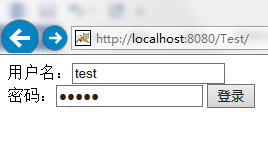
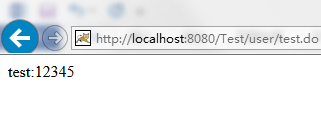
- 配置Hibernate集成
添加以下JAR包:
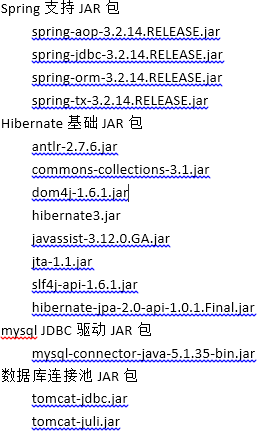
applicationContest.xml中添加Hibernate相关配置,hibernate的实体声明可以选择配置文件和注解两种方式,我个人比较倾向于配置文件方式,如下图所示:

<bean id="dataSource" class="org.apache.tomcat.jdbc.pool.DataSource">
<property name="url" value="jdbc:mysql://localhost:3306/test" />
<property name="driverClassName" value="com.mysql.jdbc.Driver" />
<property name="username" value="root" />
<property name="password" value="root" />
</bean> <bean id="sessionFactory" class="org.springframework.orm.hibernate3.LocalSessionFactoryBean">
<property name="dataSource" ref="dataSource" />
<property name="mappingLocations">
<value>classpath*:/com/test/entity/*.cfg.xml</value>
</property>
<property name="hibernateProperties">
<props>
<prop key="hibernate.show_sql">true</prop>
</props>
</property>
</bean>

由于Hibernate3必须在事务中处理数据访问,所以需要添加事务控制,个人倾向于使用aop方式,所以需要先添加tx和aop的文档配置,配置后文档声明部分代码如下:

<beans xmlns="http://www.springframework.org/schema/beans"
xmlns:xsi="http://www.w3.org/2001/XMLSchema-instance"
xmlns:context="http://www.springframework.org/schema/context"
xmlns:tx="http://www.springframework.org/schema/tx"
xmlns:aop="http://www.springframework.org/schema/aop"
xsi:schemaLocation="http://www.springframework.org/schema/beans
http://www.springframework.org/schema/beans/spring-beans-3.2.xsd
http://www.springframework.org/schema/context
http://www.springframework.org/schema/context/spring-context-3.2.xsd
http://www.springframework.org/schema/tx
http://www.springframework.org/schema/tx/spring-tx-3.2.xsd
http://www.springframework.org/schema/aop
http://www.springframework.org/schema/aop/spring-aop-3.2.xsd">

配置事务控制器,并通过aop将其织入到service切面进行事务控制,如下所示:

<bean id="txManager" class="org.springframework.orm.hibernate3.HibernateTransactionManager">
<property name="sessionFactory" ref="sessionFactory" />
</bean> <tx:advice id="txAdvice" transaction-manager="txManager">
<tx:attributes >
<tx:method name="*" propagation="REQUIRED"/>
</tx:attributes>
</tx:advice> <aop:config>
<aop:pointcut expression="execution(* com.test.service.*.*(..))" id="aopPointcut"/>
<aop:advisor advice-ref="txAdvice" pointcut-ref="aopPointcut"/>
</aop:config>

- 测试整体框架
Mysql中创建test_user表用于测试框架能否正常进行数据库的操作,此处我们测试在事务管理中进行保存操作,建表语句如下:
create table test_user (
id varchar(36) primary key,
username varchar(20) not null,
password varchar(50) not null
);
创建Hibernate实体映射文件,内容如下:

<?xml version="1.0" encoding="UTF-8"?>
<!DOCTYPE hibernate-mapping PUBLIC
"-//Hibernate/Hibernate Mapping DTD 3.0//EN"
"http://www.hibernate.org/dtd/hibernate-mapping-3.0.dtd">
<hibernate-mapping>
<class name="com.test.entity.User" table="test_user">
<id name="id" type="java.lang.String" length="36">
<column name="id" />
<generator class="uuid" />
</id> <property name="username" type="java.lang.String" length="10" >
<column name="username" not-null="true" unique="true"/>
</property> <property name="password" type="java.lang.String" length="32" >
<column name="password" not-null="true" unique="true"/>
</property>
</class>
</hibernate-mapping>

创建UserDAO,暂定位于com.test.dao下,用于处理数据库操作,代码如下:

package com.test.dao; import org.hibernate.SessionFactory;
import org.springframework.beans.factory.annotation.Autowired;
import org.springframework.stereotype.Repository; import com.test.entity.User; @Repository
public class UserDAO { @Autowired
private SessionFactory sessionFactory; public String save(User user){
return (String) sessionFactory.getCurrentSession().save(user);
} }

创建UserService,暂定位于com.test.service下,用于提供请求服务,代码如下:

package com.test.service; import org.springframework.beans.factory.annotation.Autowired;
import org.springframework.stereotype.Service; import com.test.dao.UserDAO;
import com.test.entity.User; @Service
public class UserService { @Autowired
private UserDAO userDAO; public String save(User user){
return userDAO.save(user);
} }

修改UserController如下:

package com.test.controller; import org.springframework.beans.factory.annotation.Autowired;
import org.springframework.stereotype.Controller;
import org.springframework.ui.ModelMap;
import org.springframework.web.bind.annotation.RequestMapping; import com.test.entity.User;
import com.test.service.UserService; @Controller
@RequestMapping("/user")
public class UserController { @Autowired
private UserService userService; @RequestMapping("/test")
public String test(User user,ModelMap model){
userService.save(user);
model.addAttribute(user);
return "/return";
} }

至此项目内容应该如下图所示:
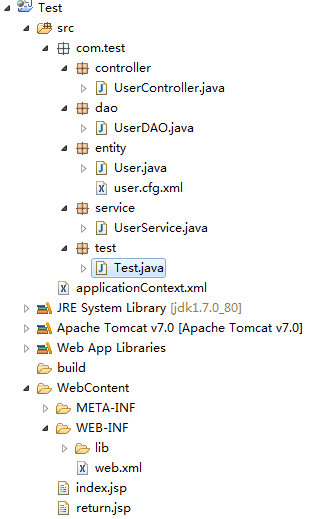
重启Tomcat后输入用户名和密码,点击按钮后查看数据库,正常结果为后台未报错且数据库有数据存入,如下图所示:

接下来我们测试下在出现异常的情况下能否正常回滚事务,修改Service代码如下:

package com.test.service; import org.springframework.beans.factory.annotation.Autowired;
import org.springframework.stereotype.Service; import com.test.dao.UserDAO;
import com.test.entity.User; @Service
public class UserService { @Autowired
private UserDAO userDAO; public String save(User user){
userDAO.save(user);
throw new RuntimeException("测试事务能否正常回滚!");
}
}

重启Tomcat后测试框架能否正常回滚,正常情况下,后台会将自定义的异常抛出,而数据库中未出现第二条数据,框架集成到此结束,之后便可进行基于框架的开发工作了。
PS:各位有什么问题或者不同看法可以留言
SpringMVC + Spring 3.2.14 + Hibernate 3.6.10的更多相关文章
- SpringMVC + Spring 3.2.14 + Hibernate 3.6.10 集成详解
注:此文档只说明简单的框架集成,各个框架的高级特性未涉及,刚刚接触框架的新人可能需要参考其他资料. PS:本次练习所用jar包都能在此下载到:http://pan.baidu.com/s/1sjmgd ...
- S2SH框架集成详解(Struts 2.3.16 + Spring 3.2.6 + Hibernate 3.6.10)
近期集成了一次较新版本的s2sh,出现了不少问题,网上资料也是良莠不齐,有的甚至就是扯淡,简单的把jar包扔进去就以为是集成成功了,在这里整理一下详细的步骤,若哪位有什么不同看法,可以留言,欢迎批评改 ...
- javaweb各种框架组合案例(四):maven+spring+springMVC+spring data jpa(hibernate)【失败案例】
一.失败案例 1. 控制台报错信息 严重: Exception sending context initialized event to listener instance of class org. ...
- SSH(Struts,Spring,Hibernate)和SSM(SpringMVC,Spring,MyBatis)的区别
SSH 通常指的是 Struts2 做前端控制器,Spring 管理各层的组件,Hibernate 负责持久化层. SSM 则指的是 SpringMVC 做前端控制器,Spring 管理各层的组件,M ...
- Springmvc+Spring+Hibernate搭建方法及实例
Springmvc+Spring+Hibernate搭建方法及实例
- SpringMVC+Spring+Hibernate的小样例
Strusts2+Spring+Hibernate尽管是主流的WEB开发框架,可是SpringMVC有越来越多的人使用了.确实也很好用.用得爽! 这里实现了一个SpringMVC+Spring+Hib ...
- Springmvc+Spring+Hibernate搭建方法
Springmvc+Spring+Hibernate搭建方法及example 前面两篇文章,分别介绍了Springmvc和Spring的搭建方法,本文再搭建hibernate,并建立SSH最基本的代码 ...
- Maven搭建springMVC+spring+hibernate环境
这次不再使用struts2做控制器,采用spring自己的springMVC框架实现. 首先,改写pom.xml文件,不需要struts2的相关jar了. pom.xml <project xm ...
- spring(一)--spring/springmvc/spring+hibernate(mybatis)配置文件
这篇文章用来总结一下spring,springmvc,spring+mybatis,spring+hibernate的配置文件 1.web.xml 要使用spring,必须在web.xml中定义分发器 ...
随机推荐
- 源码安装apache及配置转发
一. 安装Apache a) 解压:tar -xvf httpd-*; b) ./configure --prefix=/usr/oracle/apache CC="gcc ...
- hdu 2391 Filthy Rich
单纯dp 水一 处理时间点,第一行和第一列特殊处理: 其余的w[i][j]=show(w[i-1][j-1],w[i-1][j],w[i][j-1]); <span style="fo ...
- Apache Rewrite 理解
因为工作须要,查了一下Apache的文档,对当中反向引用和条件的运行做了理解和实验,以下是对Apache 2.2文档的摘录,并在上面做了实验的样例说明,希望能给一些须要深入理解的一些帮助. 其它部分就 ...
- SharePoint 2010 BCS - 概要
博客地址 http://blog.csdn.net/foxdave SharePoint 2010首次引入了BCS的概念 - Business Connectivity Service.即业务连接服务 ...
- Java Enum使用演示样品枚举
package cn.edu.shu.web.util; /** * * <p> * ClassName FileType * </p> * <p> * Descr ...
- POJ2029——Get Many Persimmon Trees
Get Many Persimmon Trees Time Limit: 1000MS Memory Limit: 30000K Total Submissions: 3656 Accepte ...
- JAVA学习 分析Servlet
一个.什么是Servlet Servlet是一种在server端执行的java编写的程序,是依照Servlet规范编写的一个java类. 二.Servlet的工作过程 如图所看到的:为了实现客户与se ...
- 【DP专辑】ACM动态规划总结
转载请注明出处,谢谢. http://blog.csdn.net/cc_again?viewmode=list ---------- Accagain 2014年5月15日 ...
- 达到HTTP合约Get、Post和文件上传功能——采用WinHttp介面
于<采用WinHttp实现HTTP协议Get.Post和文件上传功能>一文中,我已经比較具体地解说了怎样使用WinHttp接口实现各种协议. 在近期的代码梳理中,我认为Post和文件上传模 ...
- 美工与程序猿的Web工作怎样做到相对分离?
公司某老系统使用的是asp,大量的asp脚本夹在页面中.改个小样式美工就得拉着程序猿,严重占用资源.使用java比較好解决,freemarker之类的模板语言,整个宏传參就能够做到相对分离.asp的还 ...
